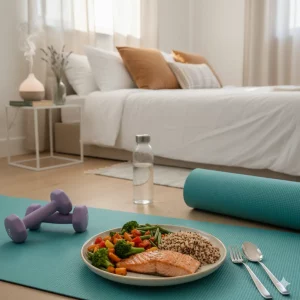Transform your body, boost your energy, and build confidence with a simple 30-day fitness challenge designed to prepare you for the holiday season.
The 30-Day Fitness Challenge to Get in Shape Before the Holidays
The holiday season often means indulgence, gatherings, and less time for self-care. That’s why a 30-day fitness challenge is the perfect way to get in shape before the holidays. By following structured workouts, improving nutrition, and building consistency, you’ll strengthen your body and mind while heading into the season with energy and confidence.
Understanding the Benefits of a 30-Day Fitness Challenge
A 30-day fitness challenge is more than just exercise—it’s a structured way to build healthier habits before the holidays arrive. Fitness experts agree that consistency is key for lasting results, and a set period of 30 days provides the right balance between intensity and sustainability. According to Wikipedia’s entry on physical fitness, fitness involves muscular strength, flexibility, cardiovascular endurance, and body composition, all of which can be improved with short-term structured programs.
The benefits of starting a 30-day fitness challenge include:
- Improved strength and stamina: Your body adapts quickly when challenged daily.
- Better energy levels: Regular workouts stimulate endorphin production, helping to reduce fatigue and stress.
- Enhanced metabolism: Consistent activity boosts calorie burn and supports fat loss.
- Stronger discipline: A fixed plan helps build accountability.
Most importantly, this fitness challenge prepares you to enjoy holiday meals and parties without guilt because your body will already be in better shape. This makes the 30-day challenge not just a physical transformation, but also a mental reset, allowing you to finish the year strong.
Building the Foundation for Success
Before diving into a 30-day fitness challenge, it’s crucial to prepare your body and mind. Proper preparation helps prevent injuries and ensures long-term adherence. This step involves three main elements: goal-setting, nutrition, and recovery.
Goal-Setting: Clearly define your objectives. For example, do you want to lose 5 pounds, gain muscle tone, or simply increase daily energy? Write down your goals and track progress weekly.
Nutrition: What you eat will directly impact your performance. Focus on whole foods—lean proteins, fruits, vegetables, and whole grains. Staying hydrated is equally important; water helps regulate body temperature and improves endurance.
Recovery: Without rest, the body cannot repair and grow stronger. Incorporate at least one rest day per week or choose active recovery activities like walking or yoga.
Another key factor is mindset. Many people give up early because they underestimate the importance of consistency. By approaching this challenge with the right mindset, you’ll set yourself up for lasting results. Remember, a strong foundation ensures that the 30-day fitness challenge is safe, enjoyable, and effective.
The Workout Plan for the 30-Day Fitness Challenge
The core of the 30-day fitness challenge is the workout structure. The goal is to balance cardio, strength, and flexibility to ensure total-body transformation.
Here’s a sample weekly breakdown:
- Day 1 – Strength Training: Focus on bodyweight exercises like squats, lunges, push-ups, and planks.
- Day 2 – Cardio: Choose activities like running, cycling, or HIIT (High-Intensity Interval Training).
- Day 3 – Core & Flexibility: Pilates or yoga to strengthen stabilizing muscles.
- Day 4 – Strength Training: Upper-body focus with push-ups, dumbbell rows, and triceps dips.
- Day 5 – Cardio & Core: Mix short sprints with crunch variations.
- Day 6 – Full Body HIIT: Combine strength and cardio in a circuit workout.
- Day 7 – Rest or Active Recovery.
Repeat this cycle for four weeks, progressively increasing intensity. Start with 20–30 minutes daily, then build to 45 minutes as your endurance improves.
Why this works: the combination of strength and cardio maximizes fat loss while building lean muscle, and flexibility training keeps joints healthy. The plan is versatile—you can adjust based on fitness level, making the 30-day fitness challenge suitable for beginners and advanced individuals alike.
Staying Motivated and Tracking Progress
The final and perhaps most critical aspect of the 30-day fitness challenge is maintaining motivation. Many people start strong but lose steam halfway. To stay consistent, focus on three areas: tracking, accountability, and rewards.
Tracking: Use a journal, fitness app, or even simple notes to log workouts, nutrition, and how you feel each day. Seeing progress written down creates motivation to keep going.
Accountability: Share your challenge with a friend or join an online fitness community. Social support greatly increases the chance of success.
Rewards: Celebrate small victories. Every week, treat yourself to a non-food reward like a new workout outfit or a massage.
Motivation also comes from visual progress. Take before-and-after photos or measure inches lost rather than just focusing on the scale. This allows you to see improvements you might otherwise miss.
Remember, the 30-day fitness challenge isn’t just about short-term results. It’s about creating momentum that carries you into the holidays and beyond. When you commit fully, the discipline and energy you gain will benefit every area of your life.
Conclusion
The 30-day fitness challenge is your chance to get in shape before the holidays with a clear plan and achievable goals. By preparing properly, following structured workouts, and staying motivated, you’ll improve your fitness and confidence just in time for the festive season. Commit today and give yourself the gift of health before the year ends.
FAQ – The 30-Day Fitness Challenge
1. Can beginners do the 30-day fitness challenge?
Yes, the challenge is adaptable. Beginners can start with shorter sessions and lighter exercises before increasing intensity.
2. What equipment do I need?
Most workouts can be done with bodyweight only. Optional items include resistance bands, dumbbells, or a yoga mat.
3. How long are the daily workouts?
Start with 20–30 minutes per day and progress to 40–45 minutes as your fitness improves.
4. What if I miss a day?
Don’t quit. Simply continue where you left off or adjust the schedule. Consistency is more important than perfection.
5. Will I lose weight in 30 days?
Results vary, but with proper nutrition and consistent workouts, many people notice fat loss, muscle tone, and increased energy.



